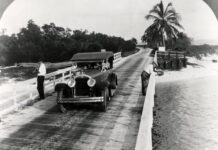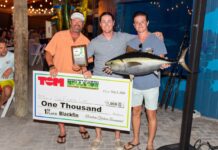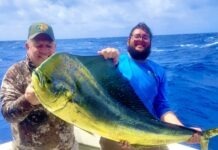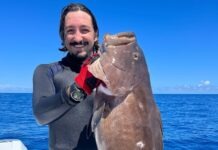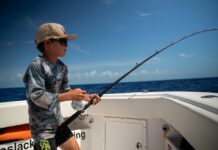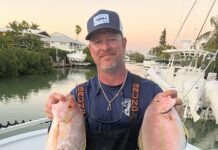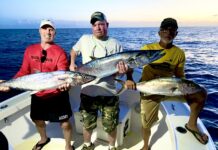
I want to start out by stating that I’m not an electric deep drop master. I know several masters and have spent a lot of time offshore with some master deep droppers, but there’s an art to it and I still have a lot to learn. The novice deep dropper may think that all you have to do is buy the equipment, buy a few good numbers, bait your hook and send them down to the bottom, wait for the strike and push the up button on an electric reel. Sometimes it’s just that easy, but most of the time, it’s a lot tougher than that.
You can learn a lot about electric deep dropping by watching YouTube videos, but until you get out there and see what’s really involved, you really don’t get it.
Captain Kavon Mehrani out of Marathon is a deep drop “rig-ologist” and has taught me a lot over the years on how to set up deep drop rigs for different species of fish. Captain Kavon is very particular about his equipment and rigging. He knows what size hook to use for each species of fish. He knows what line weight, lead weight, light scheme and bait to use in any given situation. I‘ve caught swordfish, blackbelly rosefish, tilefish, several different species of grouper and snapper while deep dropping with Captain Kavon.
Another master deep dropper is Captain Kevin Rowley out of Big Pine Key. He also rigs a lot of his own setups and catches his own bait for deep dropping. I’ve spent time with Kevin deep dropping and have caught big swordfish and huge snowy grouper with him. He taught me that one of the most important things to remember when deep dropping is to keep your line as straight up and down as possible, which can be easier said than done with high offshore winds and rushing currents.
Captain Kevin showed me that half of the battle is having a good driver at the wheel to keep the angler’s line straight. Deep dropping is really a two-person job, with an angler and driver working in harmony.
Another master deep dropper in the Florida Keys is Nick Stanczyk out of Islamorada. Captain Nick is a swordfish specialist. He’s a young world-renowned captain with a reputation for consistently catching huge swordfish on light electric deep drop rigs by knowing how to play his drag.
All three of these deep drop masters make a lot of their own rigs. I’ve seen these captains fish for swordfish using squid, barracuda bellies, bonita bellies, houndfish, ribbonfish and several other unusual baits. They all strategically sew their own baits so the baits will stay together in deep water and heavy currents.
Most of the swordfish in the Middle Keys are caught in anywhere from 1,700 to 2,100 feet of water. In that depth, a 10-pound lead cylinder weight is most effective depending on the currents and location of the Gulf Stream, whereas grey tilefish in 600 feet of water might only need a 3- or 4-pound cylinder weight.
Another thing these guys are really good at is knowing where their weight and bait is in relation to the bottom. As you’re drifting, the bottom is always dramatically changing, so you’re always checking the bottom and making adjustments. There’s a lot of give and take to keep your bait straight up and down and off the bottom. Many times if your weight’s dragging on the bottom, you’ll get hung up in the rocks and reefs. On the other hand, if your bait is too high off the bottom, you won’t get a hit. The medium level is the sweet spot. Not too high, not too low. Keep your bait in the “strike zone” a foot or two off the bottom as much as possible.
Most master deep droppers include liquid-activated flashing lights on their rigs. Normally a total of two – one nearest to the weight and one above the top hook in the five- or six-hook rig. Once you’re deeper than 250 feet, the visibility all but disappears, and it’s almost pitch black. Swordfish, blackbelly rosefish, wreckfish, oilfish, golden tilefish, queen snapper and many other deep-dwelling species feed primarily on squid. Squid illuminates in the pitch-black deep and the blinking lights get the gamefish’s attention, emulating an illuminated squid. For many grouper species we like dropping live pinfish, bonitas and ballyhoo.
Deep dropping can be the most boring type of fishing in the world until you get a fish on. It’s hard to spend a full day deep dropping on a charter. Imagine six people sitting around the boat for hours, staring at the tip of the rod and waiting for the tip to twitch. It always amazes me that when a 300- or 400-pound swordfish hits your bait at 1,700 feet deep, the rod just twitches once or twice, half an inch or so.
Deep dropping can really test your patience. If you stick to your plan and keep deep dropping, your patience can pay off with the fish of a lifetime.
Two final things to be aware of when deep dropping: Most of the swordfish grounds are right on, or near, the Bahamian border. Needless to say, stay in U.S. waters. The other thing to be aware of is as you’re drifting and deep dropping, your boat becomes a “floater,” so always keep an eye around your boat for mahi (dolphin), wahoo, tripletail and other game fish that may come around your vessel.
To book a charter with Ana Banana, call or text Capt. Joel at 813-267-4401 or Capt. Jojo at 305-879-0564, or visit anabananafishing.com.












